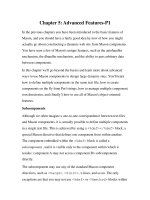Exercise dbms chapter 5 transaction processing
Bạn đang xem bản rút gọn của tài liệu. Xem và tải ngay bản đầy đủ của tài liệu tại đây (183.36 KB, 2 trang )
Subject: Database Management Systems (CO3021)
Semester 1, 2020-2021
Chapter 5: Introduction to Transaction Processing Concepts and Theory
Question 5.1. Differentiate multiuser systems from single-user systems. Give their examples.
Question 5.2. Describe different types of failures and give their examples.
Question 5.3. What is a transaction? Give 3 examples.
Question 5.4. Discuss the ACID properties of a transaction.
Question 5.5. What is a system log? What records are stored in the log? Write the content of the log for
your transactions in Question 5.3.
Question 5.6. What is a commit point? Give an example.
Question 5.7. What is a schedule? Give an example.
Question 5.8. Given the following transactions:
T1: r1(X); r1(Z); w1(X); c1;
T2: r2(Z); r2(Y); w2(Z); w2(Y); c2;
T3: r3(X); r3(Y); w3(Y); c3;
What are valid schedules? Write their log contents.
S1: r1(X); r1(Z); r3(X); r3(Y); w1(X); w3(Y); c1; c3;
S2: r2(Z); r3(X); r2(Y); r3(Y); w2(Z); w3(Y); w2(Y); a3; c2;
S3: r2(Z); r1(X); r1(Z); w2(Z); w1(X); r2(Y); w2(Y); c2; c1;
S4: r1(X); r3(Y); r1(Z); w3(Y); w1(X); c1; r3(X); c3;
Question 5.9. What are recoverable schedules? What are cascadeless schedules? What are strict
schedules?
Question 5.10. What is the recoverability characteristic of each following schedule?
S5: r1(X); r2(Z); r1(Z); r3(X); r3(Y); w1(X); c1; w3(Y); c3; r2(Y); w2(Z); w2(Y); c2;
S6: r1(X); r2(Z); r1(Z); r3(X); r3(Y); w1(X); w3(Y); r2(Y); w2(Z); w2(Y); c1; c2; c3;
S7: r1(X); r2(Z); r3(X); r1(Z); r2(Y); r3(Y); w1(X); c1; w2(Z); w3(Y); w2(Y); c3; c2;
S8: r1(A); r2(B); w1(B); c1; w2(C); c2; r3(B); r3(C); w3(D); c3;
S9: r1(A); w1(B); c1; r2(B); w2(C); c2; r3(C); w3(D); c3;
1
S10: r2(A); r3(A); r1(A); w1(B); c1; r2(B); r3(B); w2(C); c2; r3(C); c3;
S11: r2(A); r3(A); r1(A); w1(B); r3(B); w2(C); r3(C); a1; a2; a3;
Question 5.11. What are conflict-serializable schedules? Give an example.
Question 5.12. What is the conflict-serializable characteristic of each following schedule? Draw their
precedence graphs. Determine their equivalent serial schedules.
S12: r1(X); r3(X); w1(X); r2(X); w3(X);
S13: r1(X); r3(X); w3(X); w1(X); r2(X);
S14: r3(X); r2(X); w3(X); r1(X); w1(X);
S15: r3(X); r2(X); r1(X); w3(X); w1(X);
S16: r1(X); r2(Z); r1(Z); r3(X); r3(Y); w1(X); w3(Y); r2(Y); w2(Z); w2(Y);
S17: r1(X); r2(Z); r3(X); r1(Z); r2(Y); r3(Y); w1(X); w2(Z); w3(Y); w2(Y);
S18: r2(X); r1(X); r3(Y); w3(Y); r1(Y); w2(X); w1(X); w1(Y);
S19: r1(Z); r1(X): r2(Y); w2(Y); r3(X); r2(Z); w1(Z); w1(X); r2(X); w3(X); w2(X);
S20: r1(X); w1(X); r2(Y); r2(X); w2(Y); r1(Y); w2(X); r3(Y); w1(Y); r3(X); w3(X); w2(Y); w3(Y);
Question 5.13. Given two following transactions:
T4: r4(A); w4(A); r4(B);w4(B);
T5: r5(A); w5(A); r5(B);w5(B);
Prove that the schedule S21 is conflict-serializable: S21: r4(A); w4(A); r5(A); w5(A); r4(B);w4(B); r5(B);w5(B).
(Hint: reordering the nonconflicting operations in S21 until we form the equivalent serial schedule)
Question 5.14. Consider the three transactions T6, T7, and T8, and the schedules S22 and S23 given below.
Draw the serializability graph for S22 and S23, and state whether each schedule is conflict-serializable or
not. If a schedule is conflict-serializable, write down the equivalent serial schedule.
T6: r6(B); w6(B);
T7: r7(A); w7(A); r7(B); w7(B);
T8: r8(A); w8(A);
S22: r7(A); r6(B); w7(A); r8(A); w6(B); w8(A); r7(B); w7(B);
S23: r7(A); r6(B); w7(A); r7(B); r8(A); w6(B); w8(A); w7(B);
2









